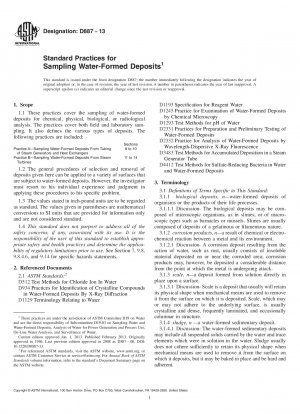ASTM D887-13
Standard Practices for Sampling Water-Formed Deposits
- Standard No.
- ASTM D887-13
- Release Date
- 2013
- Published By
- American Society for Testing and Materials (ASTM)
- Status
- Replace By
- ASTM D887-13(2022)
- Latest
- ASTM D887-13(2022)
- Scope
5.1 The goal of sampling is to obtain for analysis a portion of the whole that is representative. The most critical factors are the selection of sampling areas and number of samples, the method used for sampling, and the maintenance of the integrity of the sample prior to analysis. Analysis of water-formed deposits should give valuable information concerning cycle system chemistry, component corrosion, erosion, the failure mechanism, the need for chemical cleaning, the method of chemical cleaning, localized cycle corrosion, boiler carryover, flow patterns in a turbine, and the rate of radiation build-up. Some sources of water-formed deposits are cycle corrosion products, make-up water contaminants, and condenser cooling water contaminants.
1.1 These practices cover the sampling of water-formed deposits for chemical, physical, biological, or radiological analysis. The practices cover both field and laboratory sampling. It also defines the various types of deposits. The following practices are included:
Sections
Practice A—Sampling Water-Formed Deposits From Tubing
8199;of Steam Generators and Heat Exchangers8 to 10
Practice B—Sampling Water-Formed Deposits From Steam
8199;Turbines11 to 14
1.2 The general procedures of selection and removal of deposits given here can be applied to a variety of surfaces that are subject to water-formed deposits. However, the investigator must resort to his individual experience and judgment in applying these procedures to his specific problem.
1.3 The values stated in inch-pound units are to be regarded as standard. The values given in parentheses are mathematical conversions to SI units that are provided for information only and are not considered standard.
1.4 This standard does not purport to address all of the safety concerns, if any, associated with its use. It is the responsibility of the user of this standard to establish appropriate safety and health practices and determine the applicability of regulatory limitations prior to use. See Section 7, 9.8, 9.8.4.6, and 9.14 for specific hazards statements.
ASTM D887-13 Referenced Document
- ASTM D1129 Standard Terminology Relating to Water
- ASTM D1193 Standard Specification for Reagent Water
- ASTM D1245 Standard Practice for Examination of Water-Formed Deposits by Chemical Microscopy
- ASTM D1293 Standard Test Methods for pH of Water
- ASTM D2331 Standard Practices for Preparation and Preliminary Testing of Water-Formed Deposits
- ASTM D2332 Standard Practice for Analysis of Water-Formed Deposits by Wavelength-Dispersive X-Ray Fluorescence
- ASTM D3483 Standard Test Methods for Accumulated Deposition in a Steam Generator Tube
- ASTM D4412 Standard Test Methods for Sulfate-Reducing Bacteria in Water and Water-Formed Deposits
- ASTM D512 Standard Test Methods for Chloride Ion In Water
- ASTM D934 Standard Practices for Identification of Crystalline Compounds in Water-Formed Deposits By X-Ray Diffraction
ASTM D887-13 history
- 2022 ASTM D887-13(2022) Standard Practices for Sampling Water-Formed Deposits
- 2013 ASTM D887-13 Standard Practices for Sampling Water-Formed Deposits
- 2008 ASTM D887-08 Standard Practices for Sampling Water-Formed Deposits
- 1982 ASTM D887-82(2003)e1 Standard Practices for Sampling Water-Formed Deposits
- 1982 ASTM D887-82(1999) Standard Practices for Sampling Water-Formed Deposits
